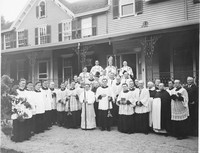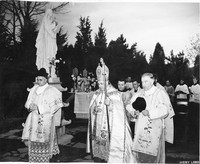

BRISTOL — Searching through the rubble of the World Trade Center after the 9/11 terrorist attacks, two Marines heard the voices of two men crying out for help, buried beneath debris.
The Marines called to them that help was on the way.
From beneath their feet, the soldiers heard the voices again: “Don’t leave us.”
“We are United States Marines,” the rescuers replied. “We are not going to leave until you are safely out of there.”
Father John Marley told the story in his homily at the Rhode Island Veterans’ Home Mass on Sunday, April 22. The example of military dedication to duty hit home for the elderly members of the congregation who had dedicated a portion of their lives to serving their country. But the example applies in a spiritual way to Father Marley’s order, the Missionary Society of St. Columban.
A week later, Father Marley gathered with his fellow Columban Fathers to welcome Bishop Thomas J. Tobin to mark the centennial of their order, and the 85th anniversary of their presence in Bristol.
At 4 p.m. on April 25, the fathers and friends gathered in the Bristol house chapel, surrounded by stained glass depictions of St. Columban’s life and representations of the world regions served by the order.
Columban lay missionary John Din read Isaiah 55:10-13 and led the congregation in praying Psalm 1. Father Charles Lintz, a Bristol house resident, blessed a commemorative Autumnalis Japanese cherry tree from inside the chapel due to heavy rains.
Father Burger showed the congregation the beribboned shovel intended to be used by Bishop Thomas J. Tobin to plant the tree, joking that he had intentionally chosen a yellow and black shovel the colors of the bishop’s favorite football team, the Pittsburgh Steelers.
Father Burger also showed the group a sign that would be placed near the tree, announcing its commemorative purpose.
“Why plant a tree? We’re all old guys,” Father Burger said during his remarks after the readings. “We may not be here to sit in its shade and enjoy its beauty, but we plant it as a gift to future generations.”
Building on the theme of the Gospel reading, John 15:1-11, Bishop Tobin said that the Columban Fathers embodied this passage by bearing good fruit throughout their century of evangelization.
Father Jeremy Rodrigues, director of the diocesan Office for Divine Worship, read the reflection during the Exposition of the Blessed Sacrament. He compared “the body broken, the blood poured out” in the Eucharist to the sacrifice of missionaries who gave their lives to evangelize those who did not know Christ.
Following the Exposition, the bishop gave those gathered a solemn Eucharistic blessing.
“It’s a very significant moment in the history of the Columban Fathers,” Bishop Tobin said after the ceremony. “We share in their joy. Their work reminds us that we’re all supposed to be missionaries as Christians, as Catholics, as disciples of Christ.”
Father Tim Mulroy, regional director of the Columbans in North America, said the occasion was especially appropriate to express gratitude to the Bristol community.
“Our blessings have come from the people of Rhode Island,” Mulroy said. “Many of these same men who were here 60 years ago are back here for retirement.”
“Bristol is like a big family,” he continued. “I know from listening to the Columbans here that they’re very grateful for this community.”
Guests were invited to a full dinner of chicken Parmesan and pasta served in the Columban Fathers’ dining hall following the commemoration.
IN THE BEGINNING
While working among the people of China from 1912 to 1916, Irish priest Edward Galvin of the Diocese of Cork and Ross encountered a widespread absence of the Gospel. He conceived the idea of a missionary society committed to the massive undertaking of evangelizing China, and co-founded the Maynooth Mission to China with Father John Blowick, a seminary professor at St. Patrick’s College, Maynooth.
The 1916 Easter Rising, a grassroots armed effort to gain Irish independence from the British crown, proved an unlikely rallying cry for recruitment to the new order. The growing militant fervor among many Irish translated into a spiritual fervor among young Catholic men with a drive toward heroism.
“If these brave lads are ready to die for Ireland, I, a priest, ought to be ready to die for Christ,” said Father John Heneghan, who had administered the sacrament of penance to Irish independence fighters the Tuam Volunteers. Heneghan soon became a Maynooth missionary himself, and his words would prove prophetic.
Galvin and Blowick’s new venture gained official approval from the Vatican in 1918. The order chose as its patron St. Columban, a 6th-century Irish priest who brought the Gospel to France and Italy, enduring many perils and much opposition.
The first deployment of Maynooth missionaries, or Columbans, embarked for China in 1920. But teachers and medical personnel would also be vital to the mission. As early as 1917, Blowick had begun calling for women in these professions to join the cause, and the Columban Sisters were established with just seven women religious journeying to China in 1924. But the Columbans found themselves in the thick of strife as combat between Communist and Nationalist forces plagued the country.
Galvin’s service to the Chinese was crowned by his appointment as Bishop of Hanyang (now Wuhan) in 1927.
Only when the victorious Communists banned the order in 1954 did the Columbans leave China; but by then their mission was entrenched in the Philippines (1929), Korea (1933), Burma (1936), Japan (1948), Peru (1951), Fiji (1952) and Chile (1953).
The road proved deadly. Columbans endured martyrdom at the hands of Japanese soldiers in World War II, North Korean troops in 1950, Communist forces in China and the Philippines from the 1920s through the 1970s, and Sendero Luminoso in 1990s Peru. Father Heneghan was captured and killed by Japanese troops at the Battle of Manila in 1945. As recently as 2001, Columban priest Rufus Halley was gunned down in the Philippines.
Undeterred, the Columbans’ drive to bring Christ’s light to dark corners of the Earth would take them to Taiwan (1978), Pakistan (1979), the U.S./Mexico border (1999) and Hong Kong, where the order’s General Council was relocated from Ireland in 2008 in order to be more central to mission areas.
And in 1933, the Columbans came to Rhode Island.
A BIG MISSION IN LITTLE RHODY
The Columban general chapter of 1932 decided to include a Spiritual Year as a transition from the order’s minor seminary to major, and began searching for a location in the States that would be close to Irish Catholics in the northeast.
Providence Bishop William A. Hickey invited the order to Rhode Island in 1933, and Bristol was chosen as the site of a new seminary. Hickey also consecrated the property, purchased by the Columbans from the McKee family of the Blithewold estate. The original seminary building was the 19th-century Gardiner House. As student numbers climbed and the structure began to deteriorate, Gardiner House was torn down and the present building was constructed in 1951. The chapel was added in 1965.
Father John Burger, 71, now Bristol house superior, vice superior of the Columbans in North America and chaplain for the Bristol Knights of Columbus completed his Spiritual Year in Bristol in 1966.
“We were novices, I guess you’d say,” said Father Burger. “On Thursday afternoons we would walk over to the Veterans’ Home and visit. It was our early introduction to ministry.”
“We used to walk to Newport,” said Father Burger. “It took about three hours. And then come back on the bus.”
The seminarians held swimming contests in the dead of winter, with plaques awarded to men who could swim to Hog Island from the edge of the seminary’s back property.
Some residential rooms, accessible without steps, were included in the chapel’s construction in 1965. The first retired Columban priests moved into this part of the house in the 1960s, while the seminary was still active.
Through the following 20 years, the number of seminarians decreased while the number of retired priests rose. Bristol was seen as an ideal place for priests’ retirement for a number of factors, including the beautiful setting and ease of travel to downtown Bristol.
The retired fathers “have all lived here for their spiritual year, so it’s not a totally unknown place to come to,” said Father Burger. Accordingly, another flanking wing to accommodate retired priests was added to the building in 1999.
But “retired” doesn’t mean inactive. The Bristol Columbans continue to minster to the community by serving the Veterans’ Home, helping Bristol and Aquidneck Island parishes with Masses, hearing confessions for Portsmouth Abbey School students, and lending meeting room space to groups like Alcoholics Anonymous and Food Addicts in Recovery Anonymous. Father Burger often presides at weddings in Newport.
New seminarians train in the Philippines, the very place where so many Columbans sacrificed their lives in their work for the Gospel.
“Our younger members are all from our former mission areas,” said Father Burger.
This is a testimony to the continuing success of the mission begun 100 years ago by Fathers Galvin and Blowick: the countries they introduced to the Gospel are now the order’s future.
Locally, the Columbans are best-known through their annual festival on the last Sunday in July. Proceeds benefit the religious order in general as well as Bristol house. The clubhouse from Blithewold’s former golf course is the festival’s center, and the grounds host a midway, a yard sale organized by Rosemary Silva of Barrington, a chicken barbecue and Rhode Island clamcakes and chowder.